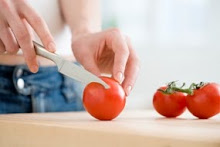Herbed oils can be wonderfully tasty additions to salads, marinades and stir fries, and as a dip for crusty breads. They are great to cook with, and make a wonderful gift. This is an excellent way to preserve flavor, aroma and the health benefits of your fresh herbs.
Prepare an herbed oil by combining two cups of a culinary oil with a half cup of finely chopped and cleaned fresh herbs or a quarter cup of your home-dried herbs. Thoroughly dry all washed herbs before adding them to the oil. Appropriate oils would include olive oil, safflower, sunflower, peanut, grapeseed, or peanut oil. Use your imagination and taste in selecting the herbs; but try garlic, basil, tarragon, rosemary, thyme, and salad burnet.
Some recipes call for just steeping the oil/herb mixture at room temperature until the flavor and aroma are to your liking. Make sure you have used a sterilized container and lid, and that the herbs are totally immersed in the oil. After a week, strain out the herbs completely, and bottle the flavored oil, again using sterile conditions and containers.
Other recipes call for heating or sauteing clean fresh herbs in the oil for a few minutes at a low temperature. When the desired flavor is achieved, the herbs are filtered out using several layers of cheesecloth, and the oil is stored in sterilized bottles and sealed. The trick with either method is to make sure there is no moisture or bits of herbs left in the oil before you bottle it.
Because there are potential dangers of storing herbs in oil, never place sprigs of herbs in the finished bottle. Although this may look attractive, you are encouraging bacterial growth. Even if the oil is stored in the refrigerator, slow bacterial contamination can happen.
Two problems can occur with any herbal oil that has been infused. One is the growth of C.botulinium, a potentially dangerous problem; the other is rancidity. These two problems are not necessarily related. Botulism toxin can be present without any off-odor, while rancid oils will have a definite off-odor. Botulism will grow in a low acid environment, and in anaerobic conditions, both of which are met with oils.
Rancidity happens when oils are exposed, over time, to air, sunlight and heat. Rancidity will not make you sick, but could be unhealthy over time, since rancid fat contains certain chemicals that can damage cells and encourage cholesterol. Always discard any oils that have a noticeable off odor.
There are certain precautions you can take when making these flavorful oils for home use. By using dried herbs in making herbal oils, you are less likely to encourage botulism because of their low water content. Always store your herbal oils in the refrigerator, and you will greatly reduce the likelihood that these two problems will occur. The FDA recommends that you make any garlic-infused oils fresh, do not allow them to remain at room temperature, and discard them after only ten days. Use all other prepared and refrigerated herbal oils within three weeks, and after that, discard them.
Papaya – For Health
15 years ago
